Personal and Professional Development Report: Acacia Care Home
VerifiedAdded on 2020/06/03
|13
|3653
|69
Report
AI Summary
This report examines the personal and professional development initiatives implemented at Acacia Care Home. It explores various approaches to self-managed learning, including conferences, seminars, and internet resources, and their impact on employee skill enhancement. The report details the benefits of self-managed learning for both individuals and the organization, highlighting improvements in presentation, teamwork, and communication skills. It includes an analysis of individual skills and competencies against professional standards, personal development needs, and opportunities for skill improvement. A personal and professional development plan is presented, outlining short-term and long-term objectives, planned activities, and reflective statements. The report also addresses work-based problem-solving, motivational techniques, and time management strategies within the context of Acacia Care Home's operations. The report emphasizes the importance of the PDP cycle, including identifying learning needs, planning, taking action, and review.
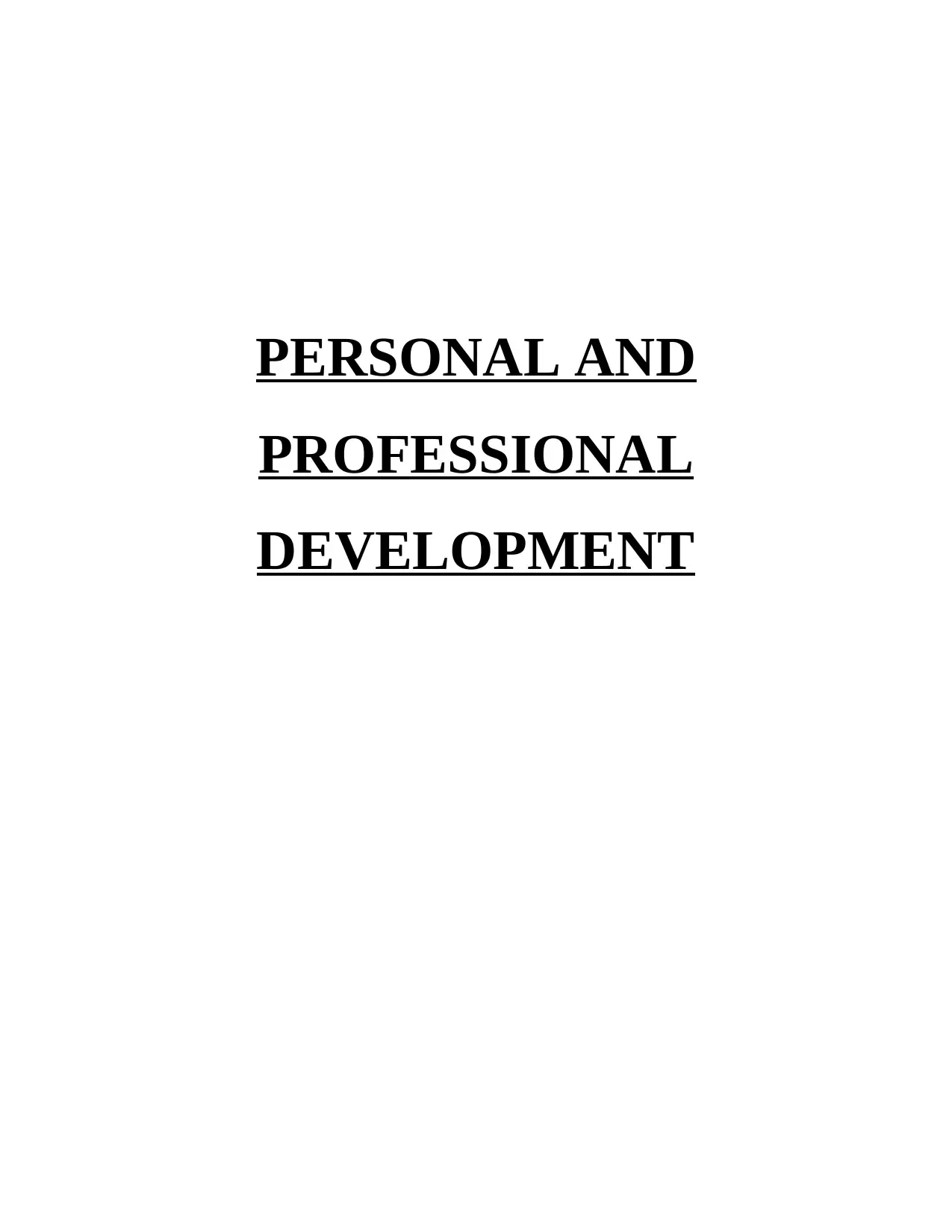
PERSONAL AND
PROFESSIONAL
DEVELOPMENT
PROFESSIONAL
DEVELOPMENT
Paraphrase This Document
Need a fresh take? Get an instant paraphrase of this document with our AI Paraphraser
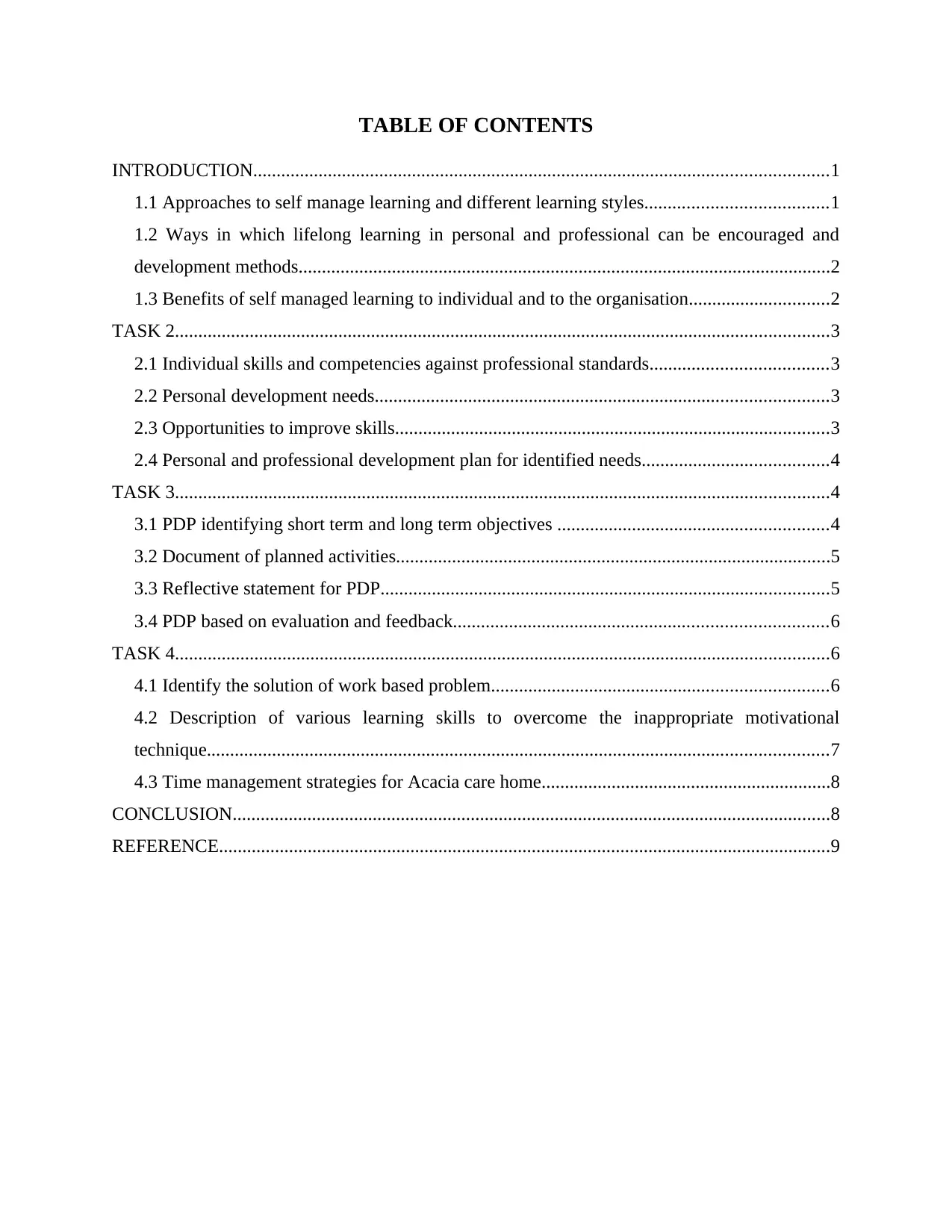
TABLE OF CONTENTS
INTRODUCTION...........................................................................................................................1
1.1 Approaches to self manage learning and different learning styles.......................................1
1.2 Ways in which lifelong learning in personal and professional can be encouraged and
development methods..................................................................................................................2
1.3 Benefits of self managed learning to individual and to the organisation..............................2
TASK 2............................................................................................................................................3
2.1 Individual skills and competencies against professional standards......................................3
2.2 Personal development needs.................................................................................................3
2.3 Opportunities to improve skills.............................................................................................3
2.4 Personal and professional development plan for identified needs........................................4
TASK 3............................................................................................................................................4
3.1 PDP identifying short term and long term objectives ..........................................................4
3.2 Document of planned activities.............................................................................................5
3.3 Reflective statement for PDP................................................................................................5
3.4 PDP based on evaluation and feedback................................................................................6
TASK 4............................................................................................................................................6
4.1 Identify the solution of work based problem........................................................................6
4.2 Description of various learning skills to overcome the inappropriate motivational
technique.....................................................................................................................................7
4.3 Time management strategies for Acacia care home..............................................................8
CONCLUSION................................................................................................................................8
REFERENCE...................................................................................................................................9
INTRODUCTION...........................................................................................................................1
1.1 Approaches to self manage learning and different learning styles.......................................1
1.2 Ways in which lifelong learning in personal and professional can be encouraged and
development methods..................................................................................................................2
1.3 Benefits of self managed learning to individual and to the organisation..............................2
TASK 2............................................................................................................................................3
2.1 Individual skills and competencies against professional standards......................................3
2.2 Personal development needs.................................................................................................3
2.3 Opportunities to improve skills.............................................................................................3
2.4 Personal and professional development plan for identified needs........................................4
TASK 3............................................................................................................................................4
3.1 PDP identifying short term and long term objectives ..........................................................4
3.2 Document of planned activities.............................................................................................5
3.3 Reflective statement for PDP................................................................................................5
3.4 PDP based on evaluation and feedback................................................................................6
TASK 4............................................................................................................................................6
4.1 Identify the solution of work based problem........................................................................6
4.2 Description of various learning skills to overcome the inappropriate motivational
technique.....................................................................................................................................7
4.3 Time management strategies for Acacia care home..............................................................8
CONCLUSION................................................................................................................................8
REFERENCE...................................................................................................................................9
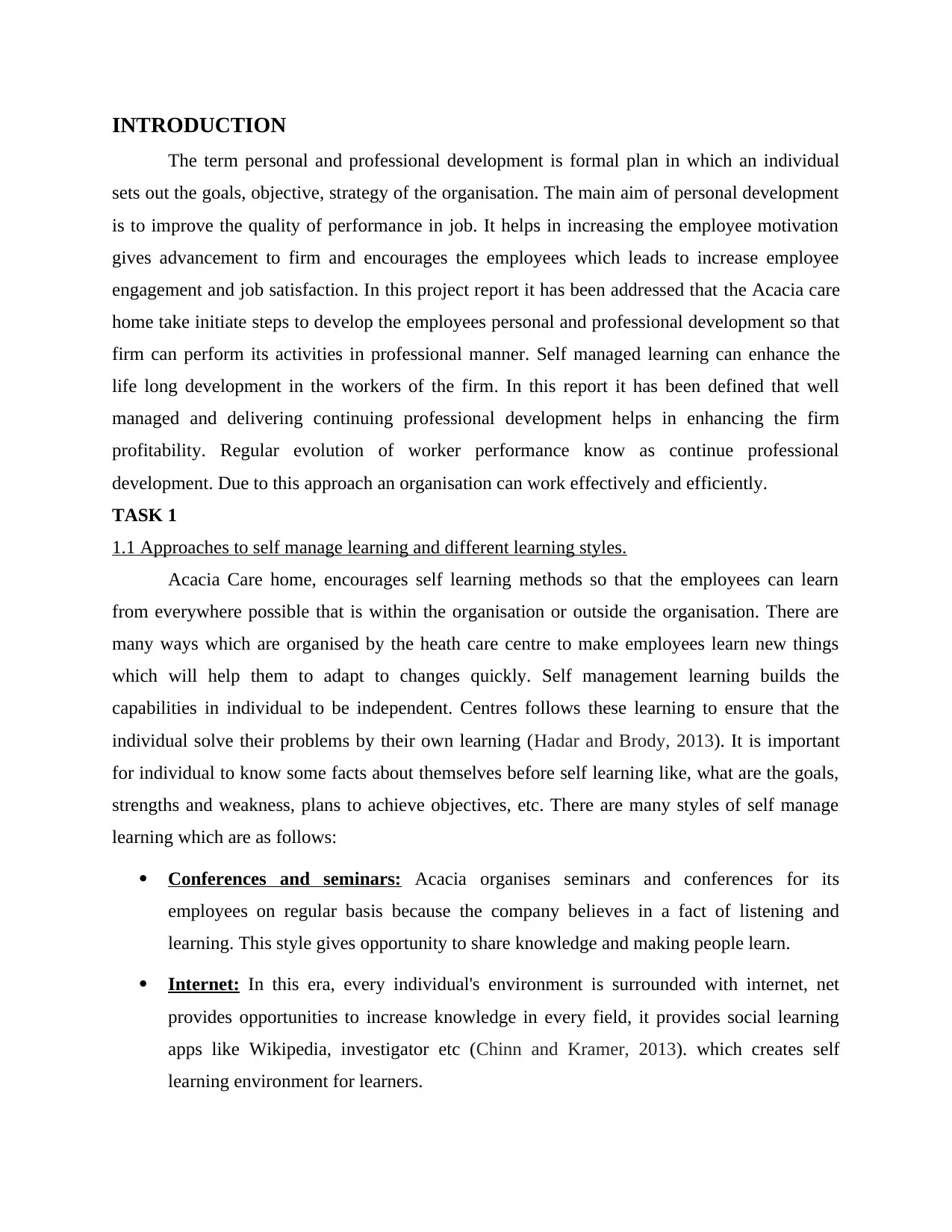
INTRODUCTION
The term personal and professional development is formal plan in which an individual
sets out the goals, objective, strategy of the organisation. The main aim of personal development
is to improve the quality of performance in job. It helps in increasing the employee motivation
gives advancement to firm and encourages the employees which leads to increase employee
engagement and job satisfaction. In this project report it has been addressed that the Acacia care
home take initiate steps to develop the employees personal and professional development so that
firm can perform its activities in professional manner. Self managed learning can enhance the
life long development in the workers of the firm. In this report it has been defined that well
managed and delivering continuing professional development helps in enhancing the firm
profitability. Regular evolution of worker performance know as continue professional
development. Due to this approach an organisation can work effectively and efficiently.
TASK 1
1.1 Approaches to self manage learning and different learning styles.
Acacia Care home, encourages self learning methods so that the employees can learn
from everywhere possible that is within the organisation or outside the organisation. There are
many ways which are organised by the heath care centre to make employees learn new things
which will help them to adapt to changes quickly. Self management learning builds the
capabilities in individual to be independent. Centres follows these learning to ensure that the
individual solve their problems by their own learning (Hadar and Brody, 2013). It is important
for individual to know some facts about themselves before self learning like, what are the goals,
strengths and weakness, plans to achieve objectives, etc. There are many styles of self manage
learning which are as follows:
Conferences and seminars: Acacia organises seminars and conferences for its
employees on regular basis because the company believes in a fact of listening and
learning. This style gives opportunity to share knowledge and making people learn.
Internet: In this era, every individual's environment is surrounded with internet, net
provides opportunities to increase knowledge in every field, it provides social learning
apps like Wikipedia, investigator etc (Chinn and Kramer, 2013). which creates self
learning environment for learners.
The term personal and professional development is formal plan in which an individual
sets out the goals, objective, strategy of the organisation. The main aim of personal development
is to improve the quality of performance in job. It helps in increasing the employee motivation
gives advancement to firm and encourages the employees which leads to increase employee
engagement and job satisfaction. In this project report it has been addressed that the Acacia care
home take initiate steps to develop the employees personal and professional development so that
firm can perform its activities in professional manner. Self managed learning can enhance the
life long development in the workers of the firm. In this report it has been defined that well
managed and delivering continuing professional development helps in enhancing the firm
profitability. Regular evolution of worker performance know as continue professional
development. Due to this approach an organisation can work effectively and efficiently.
TASK 1
1.1 Approaches to self manage learning and different learning styles.
Acacia Care home, encourages self learning methods so that the employees can learn
from everywhere possible that is within the organisation or outside the organisation. There are
many ways which are organised by the heath care centre to make employees learn new things
which will help them to adapt to changes quickly. Self management learning builds the
capabilities in individual to be independent. Centres follows these learning to ensure that the
individual solve their problems by their own learning (Hadar and Brody, 2013). It is important
for individual to know some facts about themselves before self learning like, what are the goals,
strengths and weakness, plans to achieve objectives, etc. There are many styles of self manage
learning which are as follows:
Conferences and seminars: Acacia organises seminars and conferences for its
employees on regular basis because the company believes in a fact of listening and
learning. This style gives opportunity to share knowledge and making people learn.
Internet: In this era, every individual's environment is surrounded with internet, net
provides opportunities to increase knowledge in every field, it provides social learning
apps like Wikipedia, investigator etc (Chinn and Kramer, 2013). which creates self
learning environment for learners.
⊘ This is a preview!⊘
Do you want full access?
Subscribe today to unlock all pages.

Trusted by 1+ million students worldwide
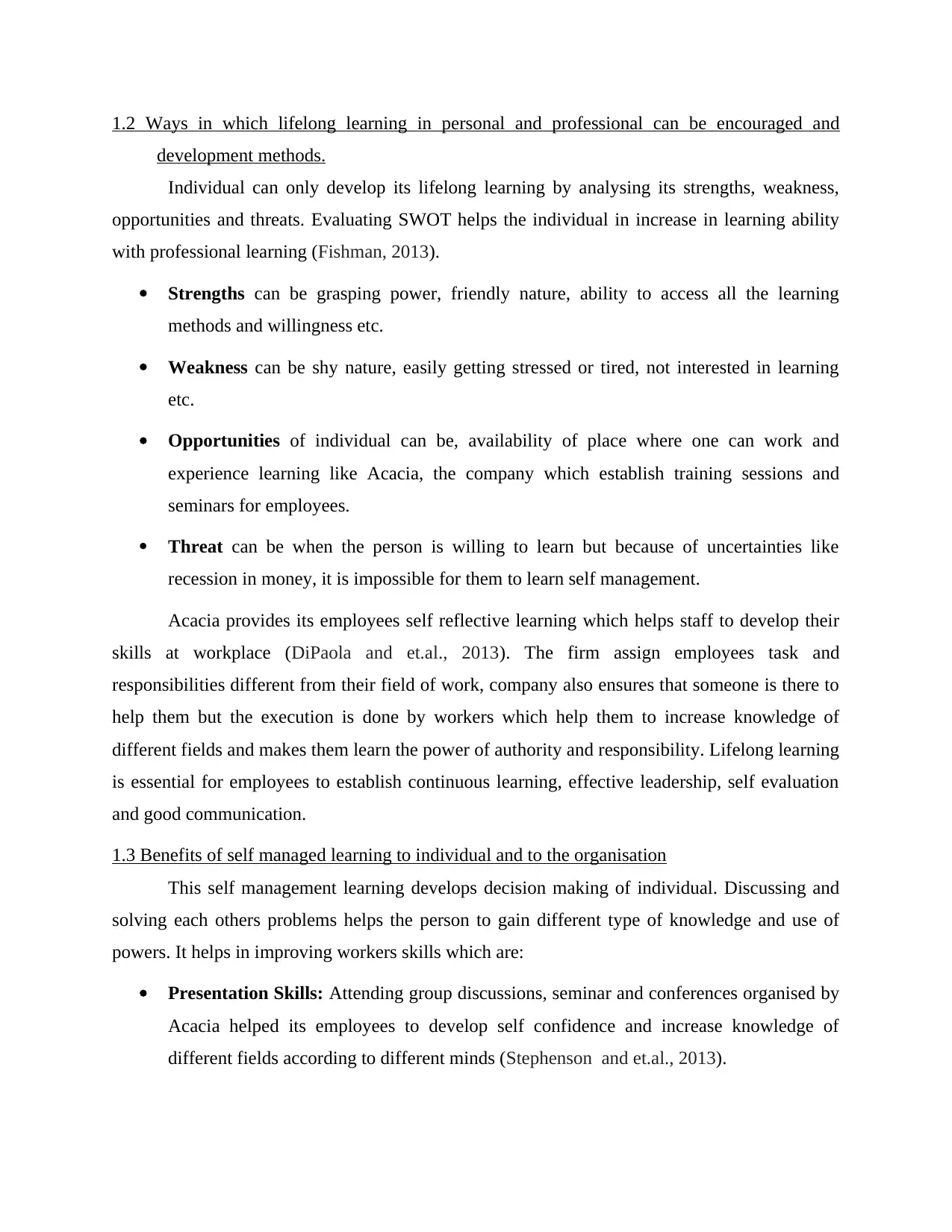
1.2 Ways in which lifelong learning in personal and professional can be encouraged and
development methods.
Individual can only develop its lifelong learning by analysing its strengths, weakness,
opportunities and threats. Evaluating SWOT helps the individual in increase in learning ability
with professional learning (Fishman, 2013).
Strengths can be grasping power, friendly nature, ability to access all the learning
methods and willingness etc.
Weakness can be shy nature, easily getting stressed or tired, not interested in learning
etc.
Opportunities of individual can be, availability of place where one can work and
experience learning like Acacia, the company which establish training sessions and
seminars for employees.
Threat can be when the person is willing to learn but because of uncertainties like
recession in money, it is impossible for them to learn self management.
Acacia provides its employees self reflective learning which helps staff to develop their
skills at workplace (DiPaola and et.al., 2013). The firm assign employees task and
responsibilities different from their field of work, company also ensures that someone is there to
help them but the execution is done by workers which help them to increase knowledge of
different fields and makes them learn the power of authority and responsibility. Lifelong learning
is essential for employees to establish continuous learning, effective leadership, self evaluation
and good communication.
1.3 Benefits of self managed learning to individual and to the organisation
This self management learning develops decision making of individual. Discussing and
solving each others problems helps the person to gain different type of knowledge and use of
powers. It helps in improving workers skills which are:
Presentation Skills: Attending group discussions, seminar and conferences organised by
Acacia helped its employees to develop self confidence and increase knowledge of
different fields according to different minds (Stephenson and et.al., 2013).
development methods.
Individual can only develop its lifelong learning by analysing its strengths, weakness,
opportunities and threats. Evaluating SWOT helps the individual in increase in learning ability
with professional learning (Fishman, 2013).
Strengths can be grasping power, friendly nature, ability to access all the learning
methods and willingness etc.
Weakness can be shy nature, easily getting stressed or tired, not interested in learning
etc.
Opportunities of individual can be, availability of place where one can work and
experience learning like Acacia, the company which establish training sessions and
seminars for employees.
Threat can be when the person is willing to learn but because of uncertainties like
recession in money, it is impossible for them to learn self management.
Acacia provides its employees self reflective learning which helps staff to develop their
skills at workplace (DiPaola and et.al., 2013). The firm assign employees task and
responsibilities different from their field of work, company also ensures that someone is there to
help them but the execution is done by workers which help them to increase knowledge of
different fields and makes them learn the power of authority and responsibility. Lifelong learning
is essential for employees to establish continuous learning, effective leadership, self evaluation
and good communication.
1.3 Benefits of self managed learning to individual and to the organisation
This self management learning develops decision making of individual. Discussing and
solving each others problems helps the person to gain different type of knowledge and use of
powers. It helps in improving workers skills which are:
Presentation Skills: Attending group discussions, seminar and conferences organised by
Acacia helped its employees to develop self confidence and increase knowledge of
different fields according to different minds (Stephenson and et.al., 2013).
Paraphrase This Document
Need a fresh take? Get an instant paraphrase of this document with our AI Paraphraser
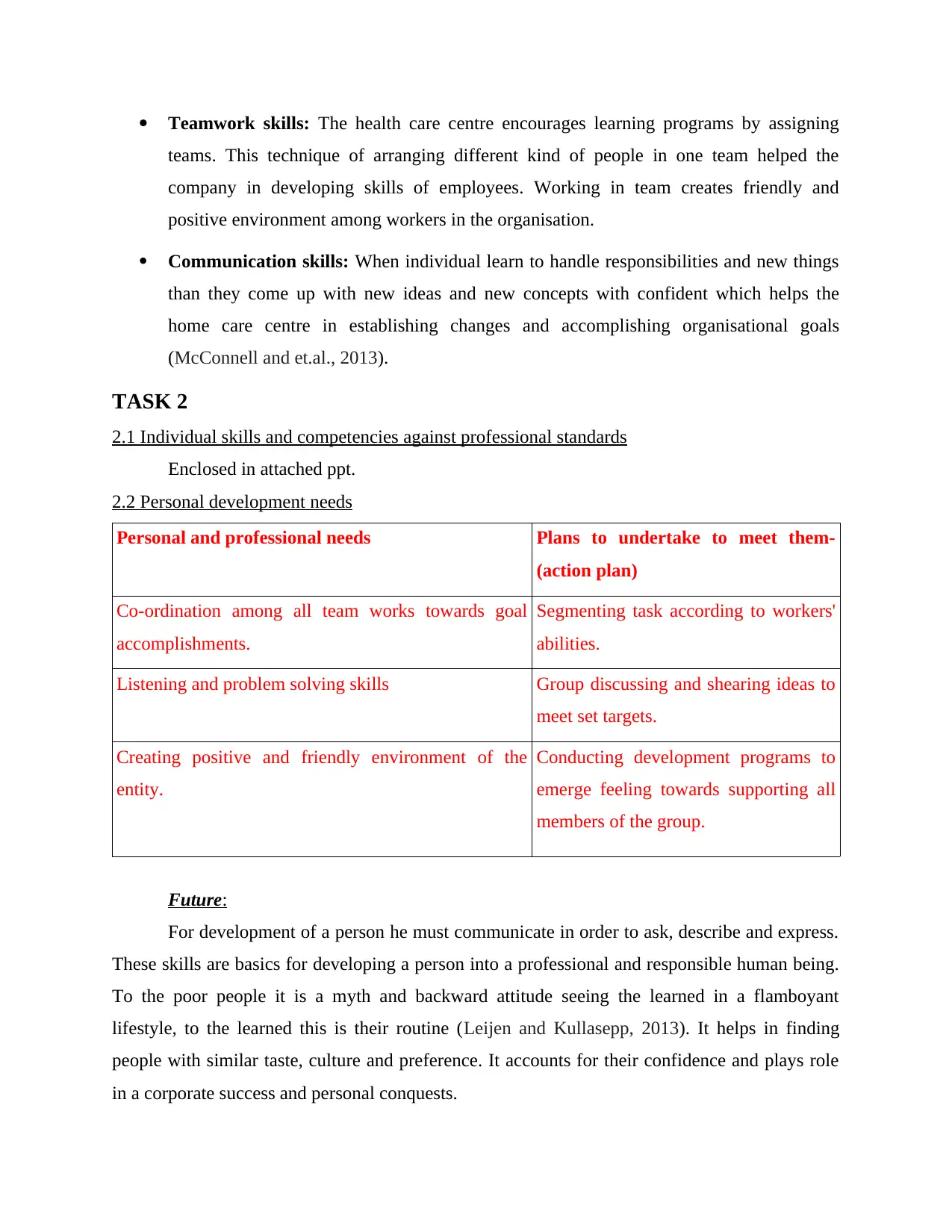
Teamwork skills: The health care centre encourages learning programs by assigning
teams. This technique of arranging different kind of people in one team helped the
company in developing skills of employees. Working in team creates friendly and
positive environment among workers in the organisation.
Communication skills: When individual learn to handle responsibilities and new things
than they come up with new ideas and new concepts with confident which helps the
home care centre in establishing changes and accomplishing organisational goals
(McConnell and et.al., 2013).
TASK 2
2.1 Individual skills and competencies against professional standards
Enclosed in attached ppt.
2.2 Personal development needs
Personal and professional needs Plans to undertake to meet them-
(action plan)
Co-ordination among all team works towards goal
accomplishments.
Segmenting task according to workers'
abilities.
Listening and problem solving skills Group discussing and shearing ideas to
meet set targets.
Creating positive and friendly environment of the
entity.
Conducting development programs to
emerge feeling towards supporting all
members of the group.
Future:
For development of a person he must communicate in order to ask, describe and express.
These skills are basics for developing a person into a professional and responsible human being.
To the poor people it is a myth and backward attitude seeing the learned in a flamboyant
lifestyle, to the learned this is their routine (Leijen and Kullasepp, 2013). It helps in finding
people with similar taste, culture and preference. It accounts for their confidence and plays role
in a corporate success and personal conquests.
teams. This technique of arranging different kind of people in one team helped the
company in developing skills of employees. Working in team creates friendly and
positive environment among workers in the organisation.
Communication skills: When individual learn to handle responsibilities and new things
than they come up with new ideas and new concepts with confident which helps the
home care centre in establishing changes and accomplishing organisational goals
(McConnell and et.al., 2013).
TASK 2
2.1 Individual skills and competencies against professional standards
Enclosed in attached ppt.
2.2 Personal development needs
Personal and professional needs Plans to undertake to meet them-
(action plan)
Co-ordination among all team works towards goal
accomplishments.
Segmenting task according to workers'
abilities.
Listening and problem solving skills Group discussing and shearing ideas to
meet set targets.
Creating positive and friendly environment of the
entity.
Conducting development programs to
emerge feeling towards supporting all
members of the group.
Future:
For development of a person he must communicate in order to ask, describe and express.
These skills are basics for developing a person into a professional and responsible human being.
To the poor people it is a myth and backward attitude seeing the learned in a flamboyant
lifestyle, to the learned this is their routine (Leijen and Kullasepp, 2013). It helps in finding
people with similar taste, culture and preference. It accounts for their confidence and plays role
in a corporate success and personal conquests.
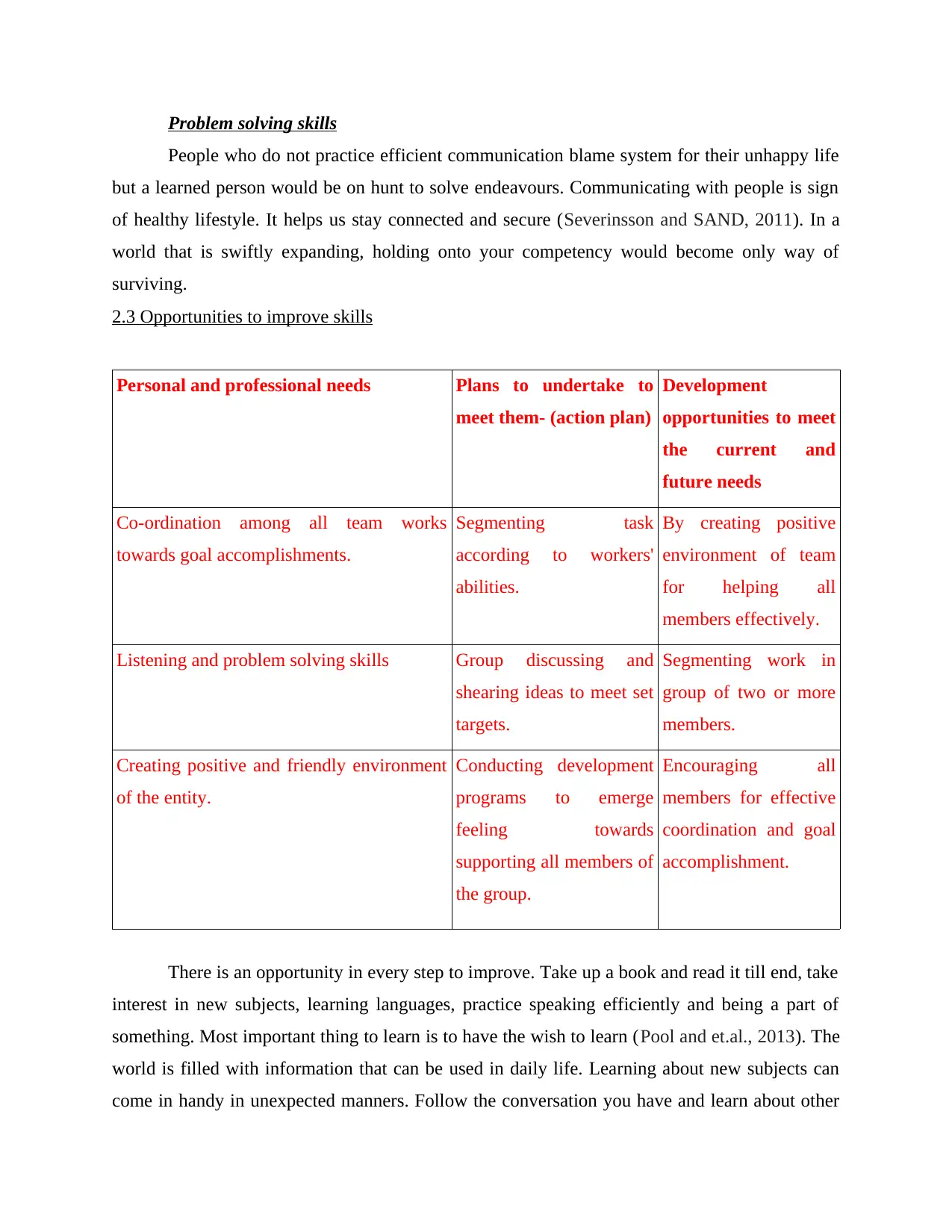
Problem solving skills
People who do not practice efficient communication blame system for their unhappy life
but a learned person would be on hunt to solve endeavours. Communicating with people is sign
of healthy lifestyle. It helps us stay connected and secure (Severinsson and SAND, 2011). In a
world that is swiftly expanding, holding onto your competency would become only way of
surviving.
2.3 Opportunities to improve skills
Personal and professional needs Plans to undertake to
meet them- (action plan)
Development
opportunities to meet
the current and
future needs
Co-ordination among all team works
towards goal accomplishments.
Segmenting task
according to workers'
abilities.
By creating positive
environment of team
for helping all
members effectively.
Listening and problem solving skills Group discussing and
shearing ideas to meet set
targets.
Segmenting work in
group of two or more
members.
Creating positive and friendly environment
of the entity.
Conducting development
programs to emerge
feeling towards
supporting all members of
the group.
Encouraging all
members for effective
coordination and goal
accomplishment.
There is an opportunity in every step to improve. Take up a book and read it till end, take
interest in new subjects, learning languages, practice speaking efficiently and being a part of
something. Most important thing to learn is to have the wish to learn (Pool and et.al., 2013). The
world is filled with information that can be used in daily life. Learning about new subjects can
come in handy in unexpected manners. Follow the conversation you have and learn about other
People who do not practice efficient communication blame system for their unhappy life
but a learned person would be on hunt to solve endeavours. Communicating with people is sign
of healthy lifestyle. It helps us stay connected and secure (Severinsson and SAND, 2011). In a
world that is swiftly expanding, holding onto your competency would become only way of
surviving.
2.3 Opportunities to improve skills
Personal and professional needs Plans to undertake to
meet them- (action plan)
Development
opportunities to meet
the current and
future needs
Co-ordination among all team works
towards goal accomplishments.
Segmenting task
according to workers'
abilities.
By creating positive
environment of team
for helping all
members effectively.
Listening and problem solving skills Group discussing and
shearing ideas to meet set
targets.
Segmenting work in
group of two or more
members.
Creating positive and friendly environment
of the entity.
Conducting development
programs to emerge
feeling towards
supporting all members of
the group.
Encouraging all
members for effective
coordination and goal
accomplishment.
There is an opportunity in every step to improve. Take up a book and read it till end, take
interest in new subjects, learning languages, practice speaking efficiently and being a part of
something. Most important thing to learn is to have the wish to learn (Pool and et.al., 2013). The
world is filled with information that can be used in daily life. Learning about new subjects can
come in handy in unexpected manners. Follow the conversation you have and learn about other
⊘ This is a preview!⊘
Do you want full access?
Subscribe today to unlock all pages.

Trusted by 1+ million students worldwide

communication skills. These skills will make an employee a better person and worker. They will
be able to finish tasks on time and stay efficient. This is also a big thing in working in team
projects, crisis or generating a good feedback (Greytak and et.al., 2013). If a person doesn't take
up these ventures he's going to implore in himself, become lethargic and a strain on community
and suffer without anyone to accompany.
2.4 Personal and professional development plan for identified needs
Enclosed in attached ppt.
TASK 3
3.1 PDP identifying short term and long term objectives
Personal and professional development program by the company evaluates the success of
the company. Acacia implements its plan by following PDP Cycle which is continuous process
to identify organisational short term and long term objectives. The PDP cycle process is as
follows:
Identify: First step in the cycle to recognize individual learning needs, Employees in the
home care centre need to do their SWOT analysis which will help them to realize where they
need to focus as per the strengths like, multi-tasking, motivation, leadership, management, etc.
Plan: Planning is setting the objective which an individual and organisation need to
accomplish. This is done to ensure smooth process learning (Hadar and Brody, 2013). The
company has defined objectives which need to reach in specific period. While planning
individual should evaluate all the market risk and environmental changes.
Action: This is execution of planned activities, in this step individual should look for
sources of learning, this could be inline, offline, books, journals, audio's, videos etc. anything
which will help employees to increase their knowledge about organisational activities and
objectives.
Reflect and review: Employees need someone to look after their performance. Acacia
has supervisor to guide and keep a check over employees learning programmes. At the end of
process manager evaluates employees learning performance and give them feedback
immediately so that they can make changes if needed (Fishman, 2013).
be able to finish tasks on time and stay efficient. This is also a big thing in working in team
projects, crisis or generating a good feedback (Greytak and et.al., 2013). If a person doesn't take
up these ventures he's going to implore in himself, become lethargic and a strain on community
and suffer without anyone to accompany.
2.4 Personal and professional development plan for identified needs
Enclosed in attached ppt.
TASK 3
3.1 PDP identifying short term and long term objectives
Personal and professional development program by the company evaluates the success of
the company. Acacia implements its plan by following PDP Cycle which is continuous process
to identify organisational short term and long term objectives. The PDP cycle process is as
follows:
Identify: First step in the cycle to recognize individual learning needs, Employees in the
home care centre need to do their SWOT analysis which will help them to realize where they
need to focus as per the strengths like, multi-tasking, motivation, leadership, management, etc.
Plan: Planning is setting the objective which an individual and organisation need to
accomplish. This is done to ensure smooth process learning (Hadar and Brody, 2013). The
company has defined objectives which need to reach in specific period. While planning
individual should evaluate all the market risk and environmental changes.
Action: This is execution of planned activities, in this step individual should look for
sources of learning, this could be inline, offline, books, journals, audio's, videos etc. anything
which will help employees to increase their knowledge about organisational activities and
objectives.
Reflect and review: Employees need someone to look after their performance. Acacia
has supervisor to guide and keep a check over employees learning programmes. At the end of
process manager evaluates employees learning performance and give them feedback
immediately so that they can make changes if needed (Fishman, 2013).
Paraphrase This Document
Need a fresh take? Get an instant paraphrase of this document with our AI Paraphraser
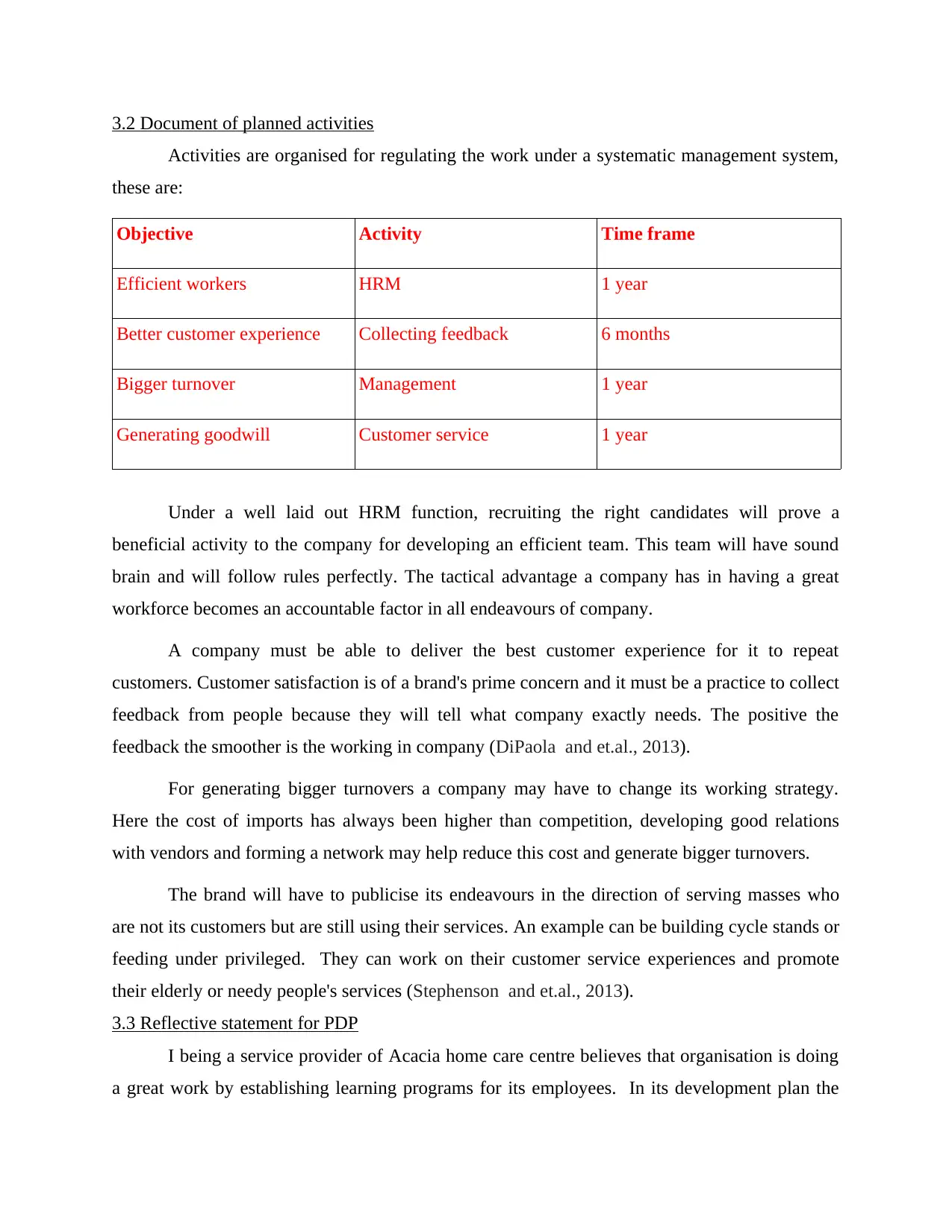
3.2 Document of planned activities
Activities are organised for regulating the work under a systematic management system,
these are:
Objective Activity Time frame
Efficient workers HRM 1 year
Better customer experience Collecting feedback 6 months
Bigger turnover Management 1 year
Generating goodwill Customer service 1 year
Under a well laid out HRM function, recruiting the right candidates will prove a
beneficial activity to the company for developing an efficient team. This team will have sound
brain and will follow rules perfectly. The tactical advantage a company has in having a great
workforce becomes an accountable factor in all endeavours of company.
A company must be able to deliver the best customer experience for it to repeat
customers. Customer satisfaction is of a brand's prime concern and it must be a practice to collect
feedback from people because they will tell what company exactly needs. The positive the
feedback the smoother is the working in company (DiPaola and et.al., 2013).
For generating bigger turnovers a company may have to change its working strategy.
Here the cost of imports has always been higher than competition, developing good relations
with vendors and forming a network may help reduce this cost and generate bigger turnovers.
The brand will have to publicise its endeavours in the direction of serving masses who
are not its customers but are still using their services. An example can be building cycle stands or
feeding under privileged. They can work on their customer service experiences and promote
their elderly or needy people's services (Stephenson and et.al., 2013).
3.3 Reflective statement for PDP
I being a service provider of Acacia home care centre believes that organisation is doing
a great work by establishing learning programs for its employees. In its development plan the
Activities are organised for regulating the work under a systematic management system,
these are:
Objective Activity Time frame
Efficient workers HRM 1 year
Better customer experience Collecting feedback 6 months
Bigger turnover Management 1 year
Generating goodwill Customer service 1 year
Under a well laid out HRM function, recruiting the right candidates will prove a
beneficial activity to the company for developing an efficient team. This team will have sound
brain and will follow rules perfectly. The tactical advantage a company has in having a great
workforce becomes an accountable factor in all endeavours of company.
A company must be able to deliver the best customer experience for it to repeat
customers. Customer satisfaction is of a brand's prime concern and it must be a practice to collect
feedback from people because they will tell what company exactly needs. The positive the
feedback the smoother is the working in company (DiPaola and et.al., 2013).
For generating bigger turnovers a company may have to change its working strategy.
Here the cost of imports has always been higher than competition, developing good relations
with vendors and forming a network may help reduce this cost and generate bigger turnovers.
The brand will have to publicise its endeavours in the direction of serving masses who
are not its customers but are still using their services. An example can be building cycle stands or
feeding under privileged. They can work on their customer service experiences and promote
their elderly or needy people's services (Stephenson and et.al., 2013).
3.3 Reflective statement for PDP
I being a service provider of Acacia home care centre believes that organisation is doing
a great work by establishing learning programs for its employees. In its development plan the
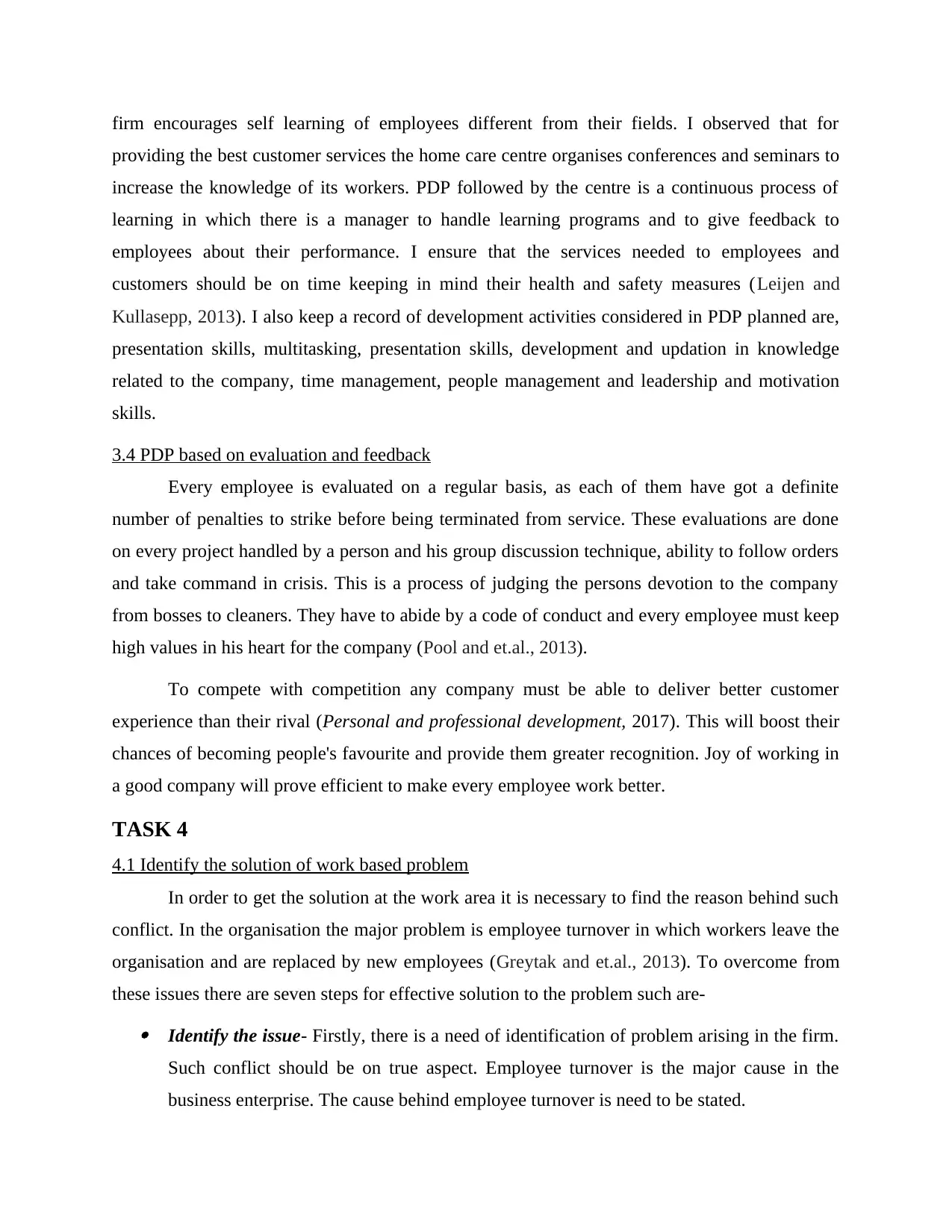
firm encourages self learning of employees different from their fields. I observed that for
providing the best customer services the home care centre organises conferences and seminars to
increase the knowledge of its workers. PDP followed by the centre is a continuous process of
learning in which there is a manager to handle learning programs and to give feedback to
employees about their performance. I ensure that the services needed to employees and
customers should be on time keeping in mind their health and safety measures (Leijen and
Kullasepp, 2013). I also keep a record of development activities considered in PDP planned are,
presentation skills, multitasking, presentation skills, development and updation in knowledge
related to the company, time management, people management and leadership and motivation
skills.
3.4 PDP based on evaluation and feedback
Every employee is evaluated on a regular basis, as each of them have got a definite
number of penalties to strike before being terminated from service. These evaluations are done
on every project handled by a person and his group discussion technique, ability to follow orders
and take command in crisis. This is a process of judging the persons devotion to the company
from bosses to cleaners. They have to abide by a code of conduct and every employee must keep
high values in his heart for the company (Pool and et.al., 2013).
To compete with competition any company must be able to deliver better customer
experience than their rival (Personal and professional development, 2017). This will boost their
chances of becoming people's favourite and provide them greater recognition. Joy of working in
a good company will prove efficient to make every employee work better.
TASK 4
4.1 Identify the solution of work based problem
In order to get the solution at the work area it is necessary to find the reason behind such
conflict. In the organisation the major problem is employee turnover in which workers leave the
organisation and are replaced by new employees (Greytak and et.al., 2013). To overcome from
these issues there are seven steps for effective solution to the problem such are- Identify the issue- Firstly, there is a need of identification of problem arising in the firm.
Such conflict should be on true aspect. Employee turnover is the major cause in the
business enterprise. The cause behind employee turnover is need to be stated.
providing the best customer services the home care centre organises conferences and seminars to
increase the knowledge of its workers. PDP followed by the centre is a continuous process of
learning in which there is a manager to handle learning programs and to give feedback to
employees about their performance. I ensure that the services needed to employees and
customers should be on time keeping in mind their health and safety measures (Leijen and
Kullasepp, 2013). I also keep a record of development activities considered in PDP planned are,
presentation skills, multitasking, presentation skills, development and updation in knowledge
related to the company, time management, people management and leadership and motivation
skills.
3.4 PDP based on evaluation and feedback
Every employee is evaluated on a regular basis, as each of them have got a definite
number of penalties to strike before being terminated from service. These evaluations are done
on every project handled by a person and his group discussion technique, ability to follow orders
and take command in crisis. This is a process of judging the persons devotion to the company
from bosses to cleaners. They have to abide by a code of conduct and every employee must keep
high values in his heart for the company (Pool and et.al., 2013).
To compete with competition any company must be able to deliver better customer
experience than their rival (Personal and professional development, 2017). This will boost their
chances of becoming people's favourite and provide them greater recognition. Joy of working in
a good company will prove efficient to make every employee work better.
TASK 4
4.1 Identify the solution of work based problem
In order to get the solution at the work area it is necessary to find the reason behind such
conflict. In the organisation the major problem is employee turnover in which workers leave the
organisation and are replaced by new employees (Greytak and et.al., 2013). To overcome from
these issues there are seven steps for effective solution to the problem such are- Identify the issue- Firstly, there is a need of identification of problem arising in the firm.
Such conflict should be on true aspect. Employee turnover is the major cause in the
business enterprise. The cause behind employee turnover is need to be stated.
⊘ This is a preview!⊘
Do you want full access?
Subscribe today to unlock all pages.

Trusted by 1+ million students worldwide
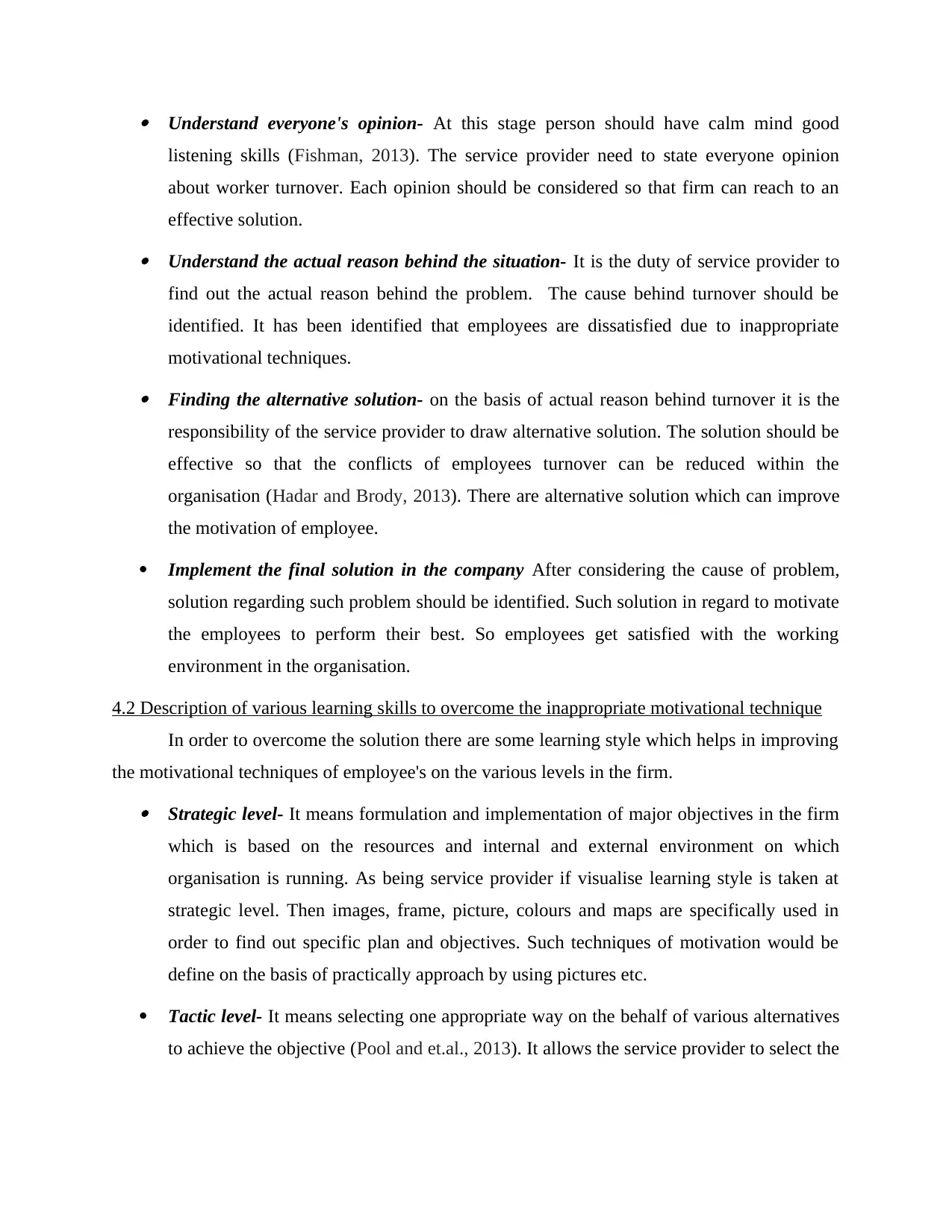
Understand everyone's opinion- At this stage person should have calm mind good
listening skills (Fishman, 2013). The service provider need to state everyone opinion
about worker turnover. Each opinion should be considered so that firm can reach to an
effective solution. Understand the actual reason behind the situation- It is the duty of service provider to
find out the actual reason behind the problem. The cause behind turnover should be
identified. It has been identified that employees are dissatisfied due to inappropriate
motivational techniques. Finding the alternative solution- on the basis of actual reason behind turnover it is the
responsibility of the service provider to draw alternative solution. The solution should be
effective so that the conflicts of employees turnover can be reduced within the
organisation (Hadar and Brody, 2013). There are alternative solution which can improve
the motivation of employee.
Implement the final solution in the company After considering the cause of problem,
solution regarding such problem should be identified. Such solution in regard to motivate
the employees to perform their best. So employees get satisfied with the working
environment in the organisation.
4.2 Description of various learning skills to overcome the inappropriate motivational technique
In order to overcome the solution there are some learning style which helps in improving
the motivational techniques of employee's on the various levels in the firm. Strategic level- It means formulation and implementation of major objectives in the firm
which is based on the resources and internal and external environment on which
organisation is running. As being service provider if visualise learning style is taken at
strategic level. Then images, frame, picture, colours and maps are specifically used in
order to find out specific plan and objectives. Such techniques of motivation would be
define on the basis of practically approach by using pictures etc.
Tactic level- It means selecting one appropriate way on the behalf of various alternatives
to achieve the objective (Pool and et.al., 2013). It allows the service provider to select the
listening skills (Fishman, 2013). The service provider need to state everyone opinion
about worker turnover. Each opinion should be considered so that firm can reach to an
effective solution. Understand the actual reason behind the situation- It is the duty of service provider to
find out the actual reason behind the problem. The cause behind turnover should be
identified. It has been identified that employees are dissatisfied due to inappropriate
motivational techniques. Finding the alternative solution- on the basis of actual reason behind turnover it is the
responsibility of the service provider to draw alternative solution. The solution should be
effective so that the conflicts of employees turnover can be reduced within the
organisation (Hadar and Brody, 2013). There are alternative solution which can improve
the motivation of employee.
Implement the final solution in the company After considering the cause of problem,
solution regarding such problem should be identified. Such solution in regard to motivate
the employees to perform their best. So employees get satisfied with the working
environment in the organisation.
4.2 Description of various learning skills to overcome the inappropriate motivational technique
In order to overcome the solution there are some learning style which helps in improving
the motivational techniques of employee's on the various levels in the firm. Strategic level- It means formulation and implementation of major objectives in the firm
which is based on the resources and internal and external environment on which
organisation is running. As being service provider if visualise learning style is taken at
strategic level. Then images, frame, picture, colours and maps are specifically used in
order to find out specific plan and objectives. Such techniques of motivation would be
define on the basis of practically approach by using pictures etc.
Tactic level- It means selecting one appropriate way on the behalf of various alternatives
to achieve the objective (Pool and et.al., 2013). It allows the service provider to select the
Paraphrase This Document
Need a fresh take? Get an instant paraphrase of this document with our AI Paraphraser

best tactics in order to solving the solution which has arisen. If logical learning style is
taken in this approach then it is based on the cause and effective relationship.
4.3 Time management strategies for Acacia care home
A detailed time table for Acacia is something they need to keep in handy every minute.
These plans need to be custom made for every resident and their needs. The nurses are supposed
to keep a few physicians and doctors numbers in handy. The conditions are supposed to be quiet
around the place so making sure nobody has to wait when there's a need to rush ( Greytak and
et.al., 2013).
The nurses must be skilled in their work and also dedicated. Measures nurses take to do
their duty can make a lot of difference, by simply putting their hearts into their work and
informing of their leaves in some advance can help the homes run more safely. Dedicating an
inventory to these homes with their regular checking will make sure no home is without a proper
on look as it is dealing with cases of old age people or ill people.
CONCLUSION
The report is concluded that personal and professional development of employees is
possible through organising training and development programs for them. In this regard,
different tools and components are described to encourage workers for better work performance.
However, time management strategies and work based situations as well their solutions are
determined through this assignment.
taken in this approach then it is based on the cause and effective relationship.
4.3 Time management strategies for Acacia care home
A detailed time table for Acacia is something they need to keep in handy every minute.
These plans need to be custom made for every resident and their needs. The nurses are supposed
to keep a few physicians and doctors numbers in handy. The conditions are supposed to be quiet
around the place so making sure nobody has to wait when there's a need to rush ( Greytak and
et.al., 2013).
The nurses must be skilled in their work and also dedicated. Measures nurses take to do
their duty can make a lot of difference, by simply putting their hearts into their work and
informing of their leaves in some advance can help the homes run more safely. Dedicating an
inventory to these homes with their regular checking will make sure no home is without a proper
on look as it is dealing with cases of old age people or ill people.
CONCLUSION
The report is concluded that personal and professional development of employees is
possible through organising training and development programs for them. In this regard,
different tools and components are described to encourage workers for better work performance.
However, time management strategies and work based situations as well their solutions are
determined through this assignment.
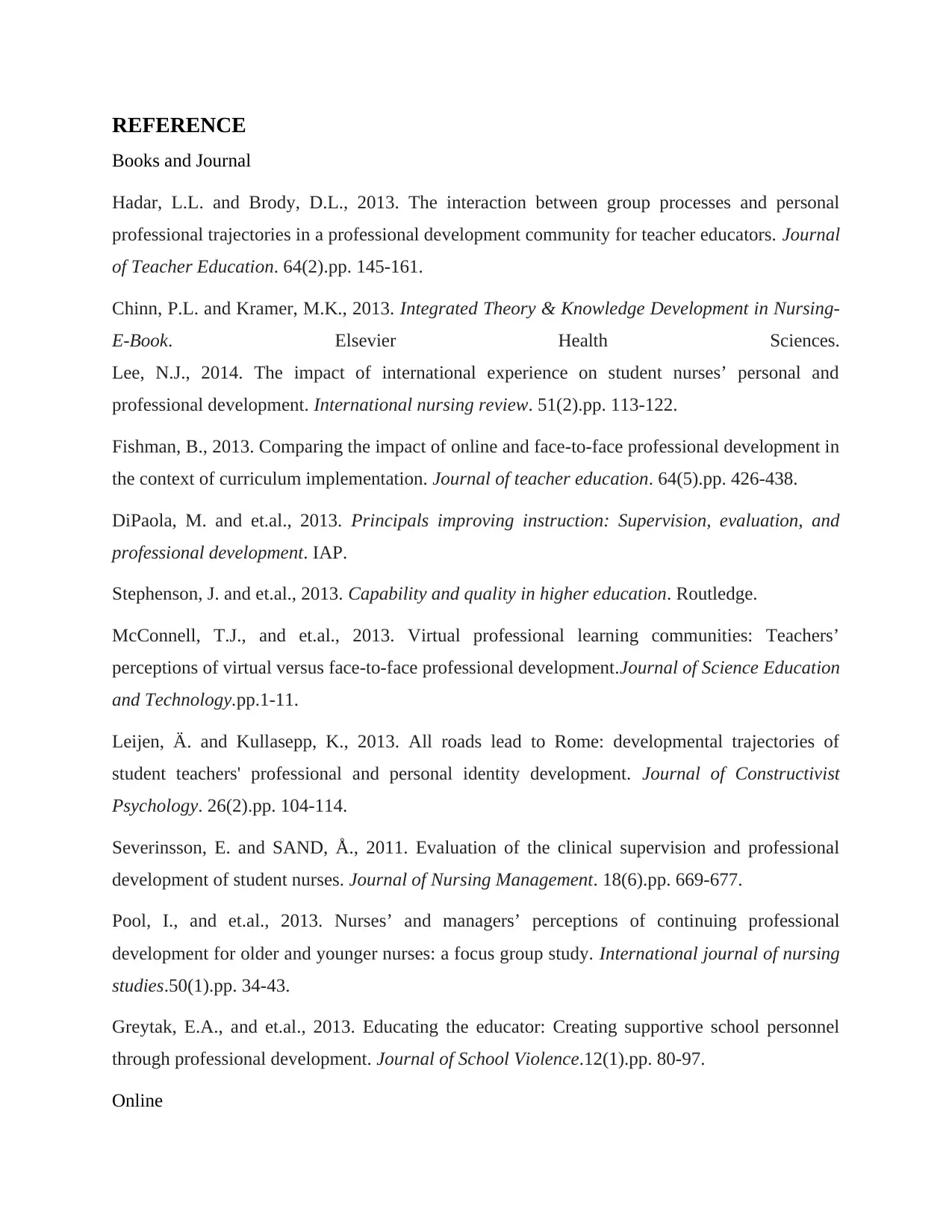
REFERENCE
Books and Journal
Hadar, L.L. and Brody, D.L., 2013. The interaction between group processes and personal
professional trajectories in a professional development community for teacher educators. Journal
of Teacher Education. 64(2).pp. 145-161.
Chinn, P.L. and Kramer, M.K., 2013. Integrated Theory & Knowledge Development in Nursing-
E-Book. Elsevier Health Sciences.
Lee, N.J., 2014. The impact of international experience on student nurses’ personal and
professional development. International nursing review. 51(2).pp. 113-122.
Fishman, B., 2013. Comparing the impact of online and face-to-face professional development in
the context of curriculum implementation. Journal of teacher education. 64(5).pp. 426-438.
DiPaola, M. and et.al., 2013. Principals improving instruction: Supervision, evaluation, and
professional development. IAP.
Stephenson, J. and et.al., 2013. Capability and quality in higher education. Routledge.
McConnell, T.J., and et.al., 2013. Virtual professional learning communities: Teachers’
perceptions of virtual versus face-to-face professional development.Journal of Science Education
and Technology.pp.1-11.
Leijen, Ä. and Kullasepp, K., 2013. All roads lead to Rome: developmental trajectories of
student teachers' professional and personal identity development. Journal of Constructivist
Psychology. 26(2).pp. 104-114.
Severinsson, E. and SAND, Å., 2011. Evaluation of the clinical supervision and professional
development of student nurses. Journal of Nursing Management. 18(6).pp. 669-677.
Pool, I., and et.al., 2013. Nurses’ and managers’ perceptions of continuing professional
development for older and younger nurses: a focus group study. International journal of nursing
studies.50(1).pp. 34-43.
Greytak, E.A., and et.al., 2013. Educating the educator: Creating supportive school personnel
through professional development. Journal of School Violence.12(1).pp. 80-97.
Online
Books and Journal
Hadar, L.L. and Brody, D.L., 2013. The interaction between group processes and personal
professional trajectories in a professional development community for teacher educators. Journal
of Teacher Education. 64(2).pp. 145-161.
Chinn, P.L. and Kramer, M.K., 2013. Integrated Theory & Knowledge Development in Nursing-
E-Book. Elsevier Health Sciences.
Lee, N.J., 2014. The impact of international experience on student nurses’ personal and
professional development. International nursing review. 51(2).pp. 113-122.
Fishman, B., 2013. Comparing the impact of online and face-to-face professional development in
the context of curriculum implementation. Journal of teacher education. 64(5).pp. 426-438.
DiPaola, M. and et.al., 2013. Principals improving instruction: Supervision, evaluation, and
professional development. IAP.
Stephenson, J. and et.al., 2013. Capability and quality in higher education. Routledge.
McConnell, T.J., and et.al., 2013. Virtual professional learning communities: Teachers’
perceptions of virtual versus face-to-face professional development.Journal of Science Education
and Technology.pp.1-11.
Leijen, Ä. and Kullasepp, K., 2013. All roads lead to Rome: developmental trajectories of
student teachers' professional and personal identity development. Journal of Constructivist
Psychology. 26(2).pp. 104-114.
Severinsson, E. and SAND, Å., 2011. Evaluation of the clinical supervision and professional
development of student nurses. Journal of Nursing Management. 18(6).pp. 669-677.
Pool, I., and et.al., 2013. Nurses’ and managers’ perceptions of continuing professional
development for older and younger nurses: a focus group study. International journal of nursing
studies.50(1).pp. 34-43.
Greytak, E.A., and et.al., 2013. Educating the educator: Creating supportive school personnel
through professional development. Journal of School Violence.12(1).pp. 80-97.
Online
⊘ This is a preview!⊘
Do you want full access?
Subscribe today to unlock all pages.

Trusted by 1+ million students worldwide
1 out of 13
Related Documents
Your All-in-One AI-Powered Toolkit for Academic Success.
+13062052269
info@desklib.com
Available 24*7 on WhatsApp / Email
![[object Object]](/_next/static/media/star-bottom.7253800d.svg)
Unlock your academic potential
Copyright © 2020–2025 A2Z Services. All Rights Reserved. Developed and managed by ZUCOL.





